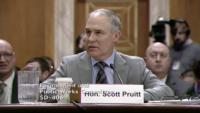In an effort to reduce the chance that other cities could face lead-contaminated drinking water like that in Flint, Mich., Gov. Rick Snyder (R) has proposed standards for lead and copper in drinking water that would be more protective than federal rules.
The March 16 proposal, part of which the state Legislature must approve, comes ahead of the U.S. Environmental Protection Agency’s Lead and Copper Rule (LCR) revision, expected later this year.
Michigan’s rules—developed with the help of Marc Edwards, a professor of civil and environmental engineering at Virginia Tech University—would lower the lead action level from EPA’s 15 parts per billion to 10 ppb. The standards also would require more stringent sampling methods, annual testing and disclosure of testing results. “The reforms announced today should be used as a guide as other states look at ways to better protect public health,” says Edwards, who, for more than 15 years, has been pushing for EPA to tighten the LCR.
First adopted in 1991, the LCR is the only regulation of its kind to require testing of water within a home. Such testing is generally required twice a year at a sampling of homes. Homeowners are given bottles and instructed to take several samples. Then, the samples are sent to a laboratory for testing.
While the rule requires that a water utility act if more than 10% of homes are found to have lead at concentrations greater that 15 ppb, that rule is not a safety standard, says Lynn Thorp, campaigns director for activist group Clean Water Action. Even the smallest level of lead in drinking water is unsafe, especially for fetuses, infants and young children. The action standard is the point at which a utility should take steps to reduce the level of lead.
In an October 2016 white paper on LCR problems, EPA admitted the standard is inadequate to protect consumers—not only because of the 15-ppb threshold but also because the rule itself is so complicated and testing is so complex that it gives utilities too much leeway. “The current structure of the rule compels additional protective actions on the part of a water system only after a potential problem has been identified, which may create a disincentive for utilities to identify potential problems with lead and copper in the drinking-water system,” the agency said in the document.
In February 2016, after the Flint crisis became known, EPA clarified testing procedures. Among other things, the agency required water utilities to eliminate the practice of flushing water through a tap before testing, which can prevent accurate detection of true levels of lead.
Using this method and cherry-picking homes unlikely to have lead problems for testing are some of the underlying problems with the curent EPA rules, Edwards says. “Flint is not unique,” he says. “This sort of thing has been happening throughout the United States. Other cities were cheating on the Lead and Copper Rule.” After EPA issued its clarification last year, many cities and states notified the agency that they are or will be more diligent about testing.
Still, without a revised regulation, last February’s clarification isn’t enforceable, Thorp says. “We thought that was a very good move,” she says of the clarification, adding, “You need that kind of thing in a regulation.”
Enesta Jones, an EPA spokeswoman, says the agency is still on track to propose revisions to the LCR this year. If all goes smoothly, new rules could be in place by 2021. Further, the agency is considering requiring utilities to replace lead service lines, a proposal that is endorsed by the American Water Works Association, Clean Water Action and the National Drinking Water Advisory Council. Without replacing those lines, the utilities can only manage risk, Thorp says.
Lead was used for smaller water pipes until 1986, and there are an estimated 6.1 million lead service lines remaining in the ground in up to 10 million U.S. homes. Several groups, including AWWA and Clean Water Action, are working together through the Lead Service Line Replacement Collaborative (lslr-collaborative.org) to help utilities voluntarily find ways to replace their service lines. It will still likely take decades to replace affected U.S. lines at a cost ranging from $16 billion to $80 billion, according to EPA.
The agency may require that, as a precursor, utilities map and make available to the public the location of existing lead water lines. It also is considering setting a health-based action level for lead according to the amount of lead in the water that could raise blood-lead levels in infants.
But Thorp and Edwards both say consumers and water utilities should not focus solely on lead while neglecting other harmful agents present in drinking water. “I do not want more of society’s scarce resources spent on this one problem than it deserves,” says Edwards, who, for this reason, actually argued against further tightening Michigan’s lead and copper rule.
“We don’t want to get so focused on lead that we forget other issues,” Thorp says.







Post a comment to this article
Report Abusive Comment